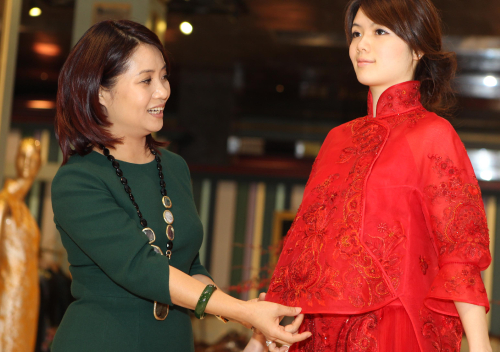|
 |
|
CULTURE IN FASHION: Guo Pei (left) showcases a wedding gown she designed (ZHANG MING) |
In the fashion world, there is a saying: What is more extravagant than flying to Paris just to try on a piece of clothing?
Currently in China, only a very small number of customers own haute couture garments, partially because in a strict sense few designers can label their products haute couture.
In France, it is stipulated by law that only brands and fashion houses meeting the standards of the Paris Chamber of Commerce are eligible to use the label haute couture.
Moreover, the list of eligible brands is updated annually, and a brand must go through a complicated certification process to maintain its status.
To qualify for the haute couture label, a brand must design made-to-order items for private clients, with one or more fittings; have a workshop in Paris that employs at least 20 full-time staff members; and present a collection in January and July of each year among other requirements.
"In a sense, haute couture is a French definition," said Zhao Qian, Director of the China office of French Federation of Fashion.
In China, the concepts of haute couture and tailor-made clothing are usually used interchangeably. The media and fashion industry generously use the term haute couture to describe the collection of many top designers. In fact, only a small number Chinese designers are the "invited members" of French Federation of Fashion, such as Ma Ke and Laurence Xu.
Ma is famed for designing dresses for Peng Liyuan, wife of Chinese President Xi Jinping, during her first foreign tours.
Xu caught the world's attention when he designed a yellow dragon gown that actress Fan Bingbing donned at the Cannes Film Festival in 2010, a replica of which is now in London's Victoria and Albert Museum.
Haute couture--that is, in a broad sense, luxury, tailor-made clothing--is a fledgling industry in China, as people's living standard improves and customers' needs are increasingly diversified.
In actuality, tailor-made clothing has long been a tradition in China. Tailor shops used to be small, and after the country's industrialization, many were shut down as people turned to mass produced ready-made clothes.
Nonetheless, there is a niche market for luxury tailored clothing. Celebrities are the main buyers of personally made attire. When celebrities get together, wearing exactly the same dress can be embarrassing. Even ordinary people would like to wear something special for important occasions in their life.
On international stages, Chinese celebrities not only want their outfit to reflect their unique personal style, but also their cultural heritage. That gives the rise to the need for home-grown designers.
Trendsetters
In 2006, Frankie Xie, the creator and art director of the JEFEN by Frankie brand, became China's first designer to take his collection to the global haute couture stage.
On October 31, 2014, he released a scenery-themed collection for 2015 together with Copenhagen Fur, a world leading fur producer.
| 